Previewing Maxiotek's MK8115 SSD Controller: Can DRAM-less Drives Make The Cut?
by Billy Tallis on May 9, 2017 8:00 AM ESTMixed Random Read/Write Performance
The mixed random I/O benchmark starts with a pure read test and gradually increases the proportion of writes, finishing with pure writes. The queue depth is 3 for the entire test and each subtest lasts for 3 minutes, for a total test duration of 18 minutes. As with the pure random write test, this test is restricted to a 16GB span of the drive, which is empty save for the 16GB test file.
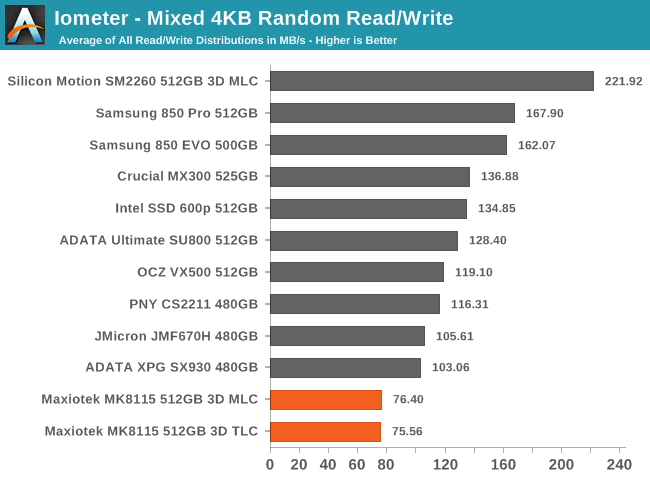
The MK8115 struggled with both random reads and random writes, so it's no surprise to see them turn in the lowest performance scores for the mixed random workload test. The MLC drive is only ahead of the TLC drive by a hair, and the next slowest drive is faster by a third.
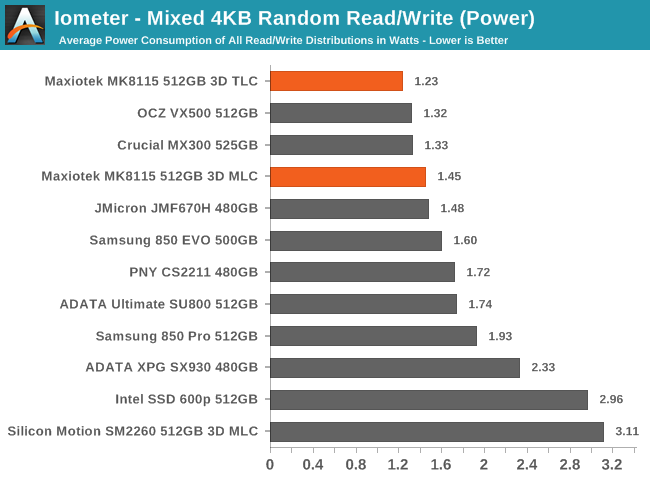
The MK8115 with TLC ends up using less power to deliver almost exactly the same performance, so the TLC drive scores a minor win for efficiency. They're both still beat by a wide range of mainstream SSDs.
 |
|||||||||
Both MK8115 drives show a normal spike in performance at the end of the test when the workload shifts to pure writes. During the rest of the test, performance is mostly constant instead of the more usual pattern of growing steadily with the proportion of writes in the workload. The TLC drive is substantially faster than the MLC drive in the initial all-reads phase of the test, but it is slightly slower through the middle of the test and that gives it the slower overall average.
Mixed Sequential Read/Write Performance
The mixed sequential access test covers the entire span of the drive and uses a queue depth of one. It starts with a pure read test and gradually increases the proportion of writes, finishing with pure writes. Each subtest lasts for 3 minutes, for a total test duration of 18 minutes. The drive is filled before the test starts.
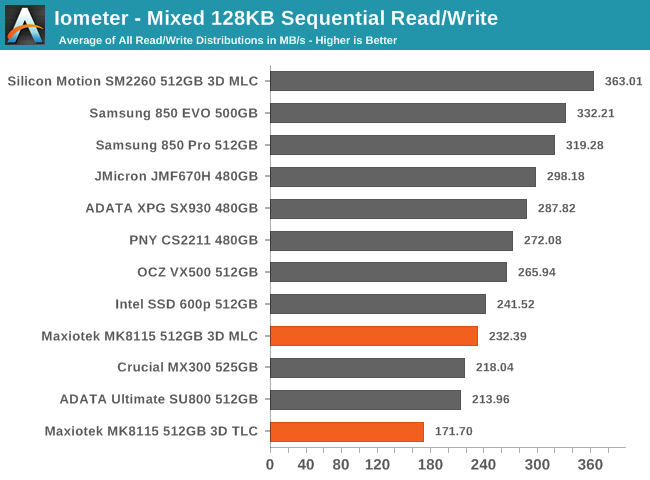
The MK8115 drive with MLC has much higher average performance on the mixed sequential workload test than its TLC counterpart, which is quite clearly the slowest drive. The MLC manages to outperform two TLC drives, but doesn't come close to matching the next slowest MLC drive on this test.
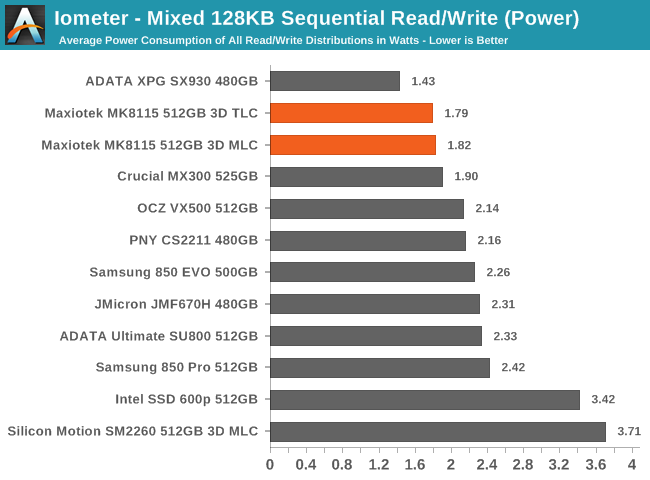
Both MK8115 drives draw about the same amount of power during the mixed sequential workload test. The MLC drive requires slightly more power but is substantially more efficient due to its higher performance, and it actually beats the Crucial MX300 for efficiency here.
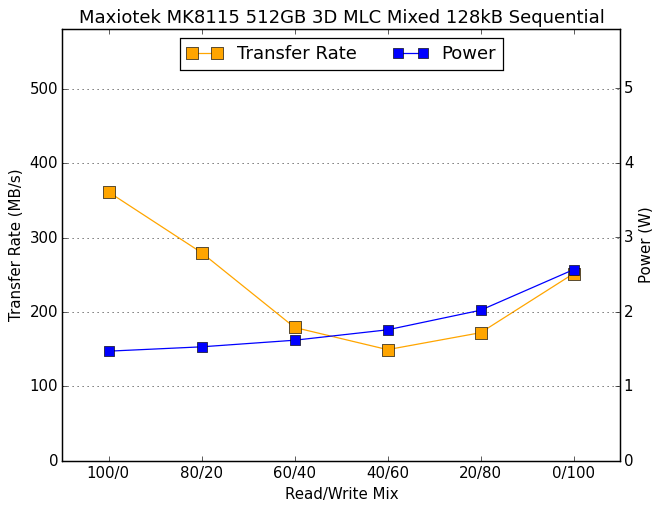 |
|||||||||
The MLC drive's performance curve across the mixed sequential test is the U shape that is normal for mainstream SSDs, though the minimum performance of around 150MB/s is a bit on the low side. The TLC drive by contrast slows down steadily as more writes are added, and doesn't recover any performance near the end of the test.










60 Comments
View All Comments
jabber - Tuesday, May 9, 2017 - link
Its like Video Recorders or DVD players. The first ones weighed 30 kilos and were built like they were made during the Industrial Revolution. By the time they stopped making them they weighed 3 kilos, had 70% fewer parts and were mostly plastic.Magichands8 - Tuesday, May 9, 2017 - link
Yep! Prices are getting higher in many cases even if they aren't dropping AND performance is either mediocre or just getting worse. Like I've said before, somewhere there are people buying such products. I don't know who they are or what's wrong withe them but I guess manufacturers are going to continue the trend for as long these people have money to lose. Even though it's dismaying to see I won't have much trouble waiting them out though. There's just very little value in most current offerings.MajGenRelativity - Tuesday, May 9, 2017 - link
I'm not sure of an instance where performance has dropped in the same price band over the past couple of years. Please feel free to enlighten meBrokenCrayons - Tuesday, May 9, 2017 - link
I'm one of those people buying such things. In my case, I was using mechanical hard disks until the middle of last year and I'm slowly (due to unusually high NAND prices) purchasing low performance SSDs for my home computers. Cheap, relatively slow SSDs still let me enjoy faster and more responsive storage. Since I'm not a power user or someone that's interested in waving around my consumer electronics like they're an extension of my reproductive organs, I have no want or need for the fastest and most expensive tier of solid state storage.While you wonder what's wrong with us for our purchases, we wonder what's wrong with you for being worried about what we buy when you can simply mind your business and buy a higher end product meant to meet your needs or desires.
MajGenRelativity - Tuesday, May 9, 2017 - link
I definitely respect your choices, as even a low-end SSD can best a HDD for metrics a typical home user would care about.melgross - Tuesday, May 9, 2017 - link
Right now, there are memory shortages. NAND shortages are expected to last until the end of the year. Then prices will begin dropping again.beginner99 - Wednesday, May 10, 2017 - link
Yeah if this continues it will take less than a year and they will actually manage to perform worse than HDDs.JimmiG - Wednesday, May 10, 2017 - link
I agree, unless you absolutely need more SSD storage right now, I'd recommend holding off until next year.MajGenRelativity - Tuesday, May 9, 2017 - link
I just hope the shortage is going to end, and we can go back to cheaper SSDs. I'm also unsure of the usefulness of this drive, but I can see it being used in systems a notch above budget systems.looncraz - Tuesday, May 9, 2017 - link
I just want a 2TB SSD that costs $200 US and performs better than a hard drive (no spin up delays, lower latency, no moving parts).I could deal with 150MB/s transfer rates and even 2ms latencies for that. Still worlds better than the hard drives I use for storage now considering I have to spin them down as they are only accessed every few hours a couple times a day (but then stream data at 40MB/s+ for a couple hours).
I would buy three without hesitation.